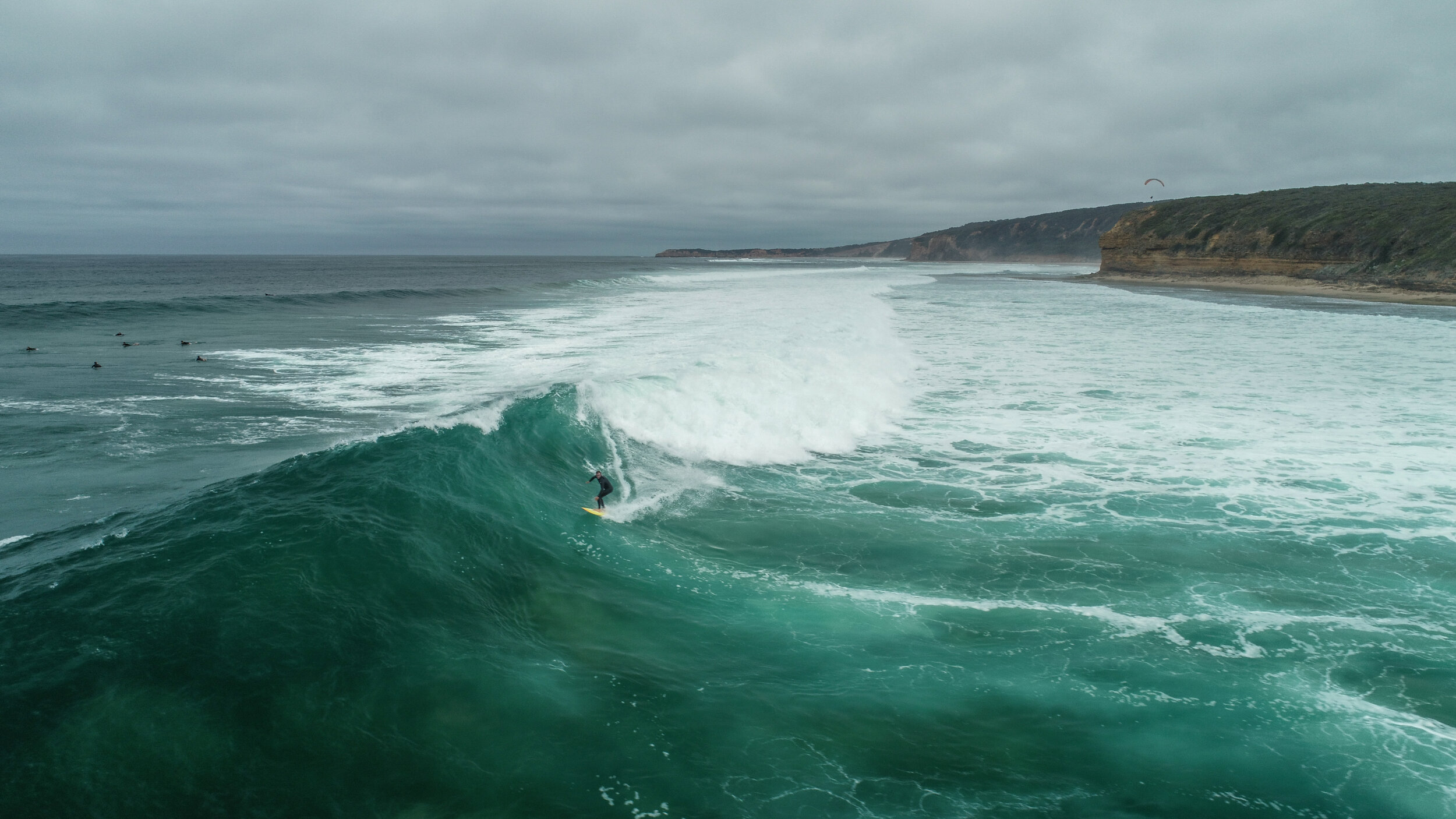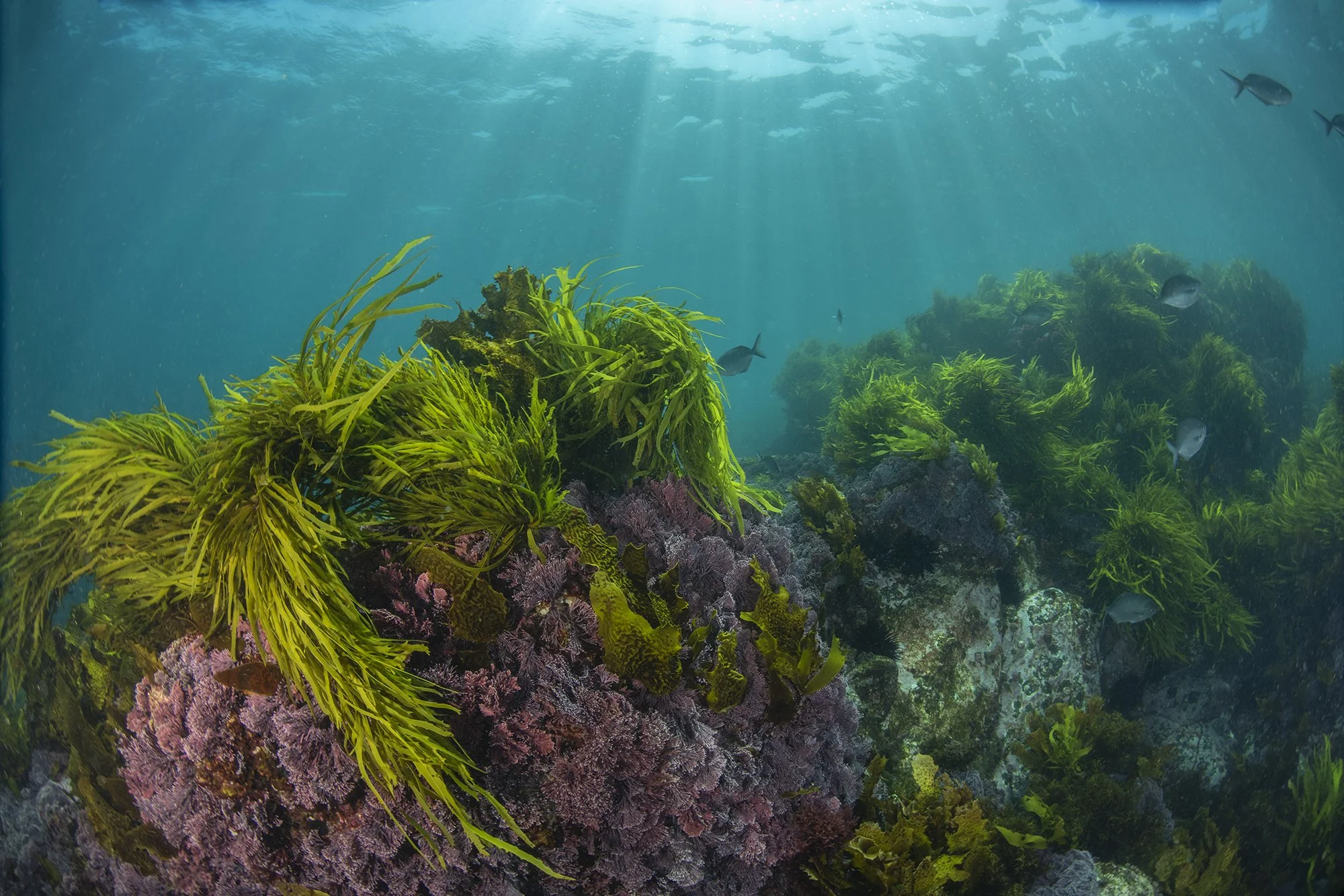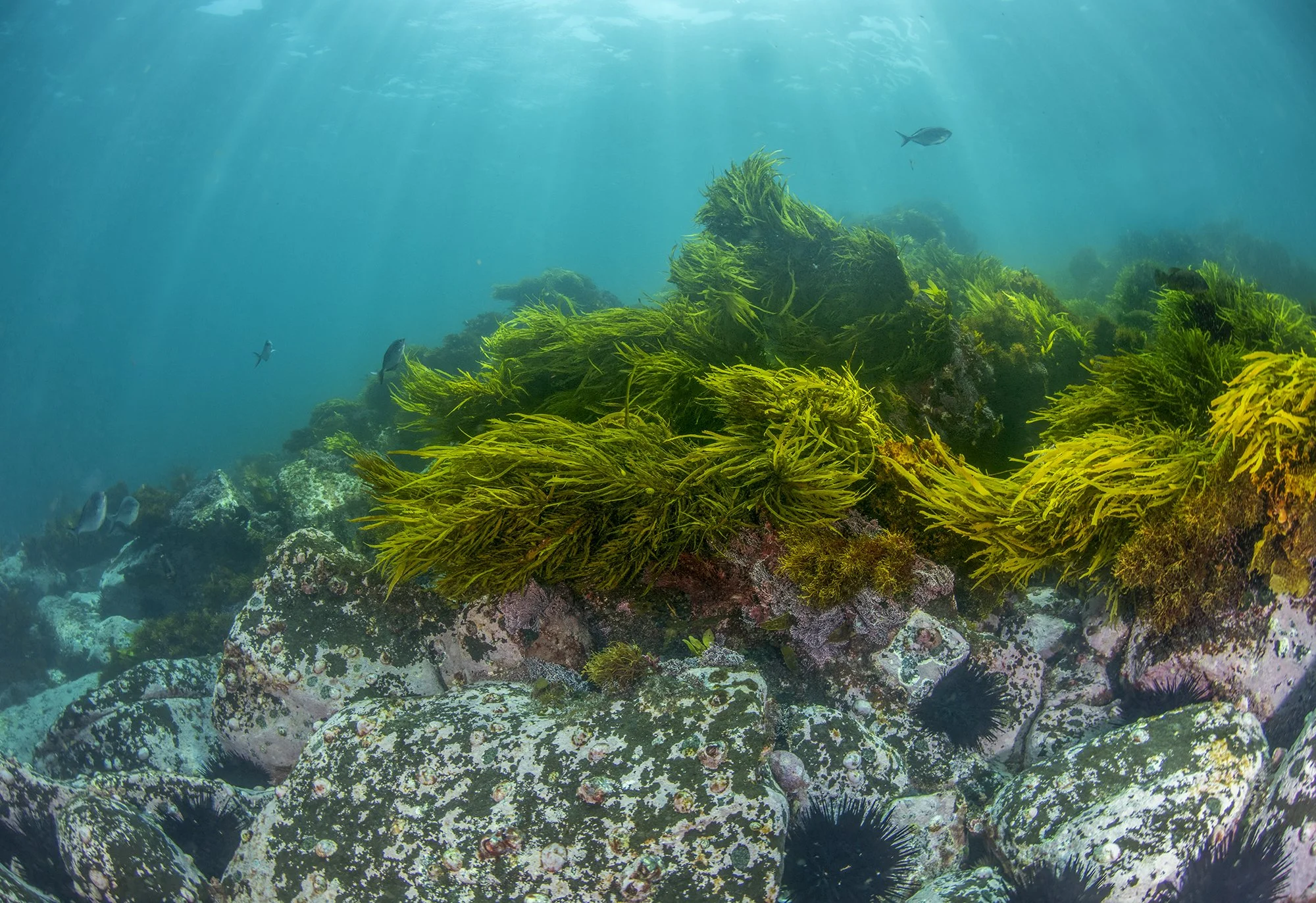
Reading the Reef, Tracking Change
Nathan Knott’s Work on the Great Southern Reef
As a Principal Research Scientist working at the intersection of research, policy and management, Dr. Nathan Knott brings almost three decades of experience to help us understand temperate marine systems. From long-term monitoring of marine protected areas to tracking the movement of fish and assessing a wide range of human impacts, his work helps inform decisions that shape the future of the Great Southern Reef.
But how did he get here? In this article, we trace Nathan’s path from an early fascination with ecological processes to his work influencing management and conservation policy today. Along the way, we explore the challenges of balancing marine protection with industry, the power of collaboration through the Great Southern Reef Research Partnership, and why long-term monitoring is critical in a rapidly changing ocean.
Cunjevoi and the Curiosity That Launched a Career
On the rugged shores of New South Wales, between the shifting tides and rocky outcrops, a simple yet remarkable organism has held Nathan Knott’s curiosity for years. The cunjevoi - a humble sea squirt that forms dense beds across NSW’s rocky shores. Not on top of the list of charismatic marine species, but for Nathan, it’s a testament to adaptation and the hidden complexity of life beneath the ocean’s surface. His early research into how this remarkable invertebrate can live on wave-pounded rocky reefs and take advantage of the fluid dynamics of this water movement to feed and thrive has in many ways shaped his scientific mindset-one that has since guided his work and enthusiasm for research at the intersection of policy and management of our biodiversity along Australia’s vast temperate coastline.
Nathan’s path into marine science wasn’t necessarily a straight one. In part like the classic story of a childhood spent obsessing over rockpools, his interest in marine ecology stemmed from a broader fascination with how natural systems function - and, more critically, how they respond to human impact. He first studied terrestrial ecology at the University of Wollongong before diving into marine research during his university years, quickly realising that the coastal environment provided an ideal lens to study both ecosystem processes and anthropogenic change.
His honours research on the feeding mechanics of cunjevoi may have seemed niche at first, but it set the tone for a career grounded in scientific curiosity, experimental approaches, and a deep appreciation for how species interact with their environment and appreciating the organisms that other people often overlook. It wasn’t long before he found himself at the University of Sydney, working with Tony Underwood, and at the University of Melbourne with Mick Keough - both leading international figures in experimental marine ecology and assessing human impacts on the marine environment. Here, Nathan honed his ability to untangle the complexity of human-driven environmental change, a skill that would become central to his future role as a government scientist carefully designing and doing the research to provide data and knowledge to navigate the delicate balance between human activities and biodiversity conservation.
Science for Management
Nathan is quick to point out that marine parks aren’t the only tool in the conservation toolbox. While sanctuary zones have led to clear increases in species abundance and size, he sees them as part of a broader strategy that must also include fisheries management, habitat restoration, and sustainable industry engagement. “Marine parks are powerful,” he says, “but they’re not a silver bullet. What we really need is a layered approach that integrates multiple management and conservation strategies.”
Eastern Fiddler Ray Trygonorrhina fasciata at Batemans Bay by Scott BennettNathan’s career took a direct step from theoretical studies into management and real world impact, when he moved into marine protected area (MPA) research. Tasked with assessing the effectiveness of NSW Marine Parks, he became deeply involved in long-term ecological monitoring - a crucial component of marine conservation. “Without data, we don’t know where we stand,” he emphasises. “It’s like trying to manage the economy without knowing any financial metrics - it’s just not possible.”
His research has helped shed light on the real-world impacts of sanctuary zones, particularly in terms of biodiversity recovery, ecological resilience and the importance of local habitat and the entire seascape. Using acoustic tracking, he and his team of PhD students and Fisheries Technicians have been able to map how species like luderick, yellowfin bream, blue spotted flathead, smooth rays, fiddler rays and Port Jackson sharks move within and beyond protected areas, revealing surprising patterns of site attachment and dispersal.
Significance of Long-Term Monitoring
One of the persistent challenges in marine management is ensuring that research doesn’t just provide a snapshot in time - which can be potentially misleading - and instead aim to confidently capture the real long-term ecological trends on the Great Southern Reef. Nathan emphasises the importance of consistent monitoring to understand how marine ecosystems respond to changes-both natural and human-driven. However, he also acknowledges the difficulties of maintaining these datasets.
Nathan Knott conducting Surveys by Toni Cooper“Long-term monitoring is expensive and logistically challenging. It requires commitment, not just from scientists, but from governments and funding bodies who recognise the value of tracking changes over decades rather than just short-term studies.” Without these datasets, he explains, it’s difficult to separate natural variability from human-driven impacts, making it harder to design effective management strategies.
Two Decades of Data
Nathan’s research has been instrumental in quantifying these shifts over time. His team has built time series spanning two decades, covering habitats from deep reefs at 40 metres to intertidal rocky shores. “We’re tracking biodiversity patterns, how fish populations are performing, and the broader changes happening across marine protected areas,” he says. These long-term datasets provide the foundation for evaluating management actions - whether it’s the effectiveness of sanctuary zones, species recovery, or emerging conservation challenges.
Acoustic tracking has played a major role in these efforts, revealing unexpected patterns of fish movement and site attachment. “We’ve been doing a lot of acoustic tracking work with fishes, and often their movement patterns are much smaller than what we would have initially predicted,” he says. This has direct implications for the design of marine parks and sanctuary zones, reinforcing the need for strategic spatial management.
Surprising Secrets of Fish Movement
Smooth ray at Jervis Bay by Wobbegone FreediveFast-paced Changes
Long term data is particularly critical because the speed of change in marine ecosystems is outpacing historical expectations. “Even within my working lifetime, the change has been phenomenal,” Nathan says, pointing to a recent Nature publication his team contributed to. “It showed demonstrable effects over very large spatial scales in really short spans of a few decades - well beyond what I would have expected to see change within that time.”
Climate change is the dominant driver of these rapid shifts, altering species distributions and reshaping entire reef ecosystems. “We’re seeing really significant changes-both losses and gains of species,” he says. But it’s not just climate; human activity has made the seascape more crowded than ever, with multiple overlapping pressures affecting marine life. Large-scale impacts like fishing, pollution, and coastal development interact with climate stressors, complicating management and conservation efforts.
Images from a recent survey expedition to Batemans Bay by Toni Cooper and Scott BennettLetting the Data Speak
But for these findings to translate into action, they need to reach beyond the scientific community. “The key thing for me – and I am a scientist and not an advocate,” Nathan explains. “Is that I go in, quantify the changes, and assess the effectiveness of management actions.” Then by putting rigorous science into the hands of policymakers, resource managers, and the public, his work ensures that knowledge and decisions about the Great Southern Reef are backed by the best available data and not guesswork.
The Urchin Dilemma: A Shifting Seascape
Nathan has been closely involved in research on Centrostephanus rodgersii, the longspined urchin whose range expansion is reshaping reefs along the Great Southern Reef. While urchin barrens are often framed as a new crisis, he emphasises that the species is native to NSW and has long been a major grazer along the coastline. However, warming waters and shifting predator populations are enabling it to push further south into Victoria and Tasmania, with consequences for kelp forests and fisheries.
One of the key unknowns is the role of predators in keeping urchin numbers in check. Nathan and PhD student Jeremy Day have been investigating whether species like snapper, blue groper, and rock lobster significantly control urchin populations, but their findings have been complex. We were surprised that predation by big urchin predators wasn't as common as we expected,” he explains. “It could be that urchins are only really vulnerable when they’re small, or maybe there’s been a long-term perturbation that’s allowed them to proliferate.
Harvesting a Solution?
With urchin numbers rising, commercial harvesting has emerged as a potential management tool. Nathan acknowledges the benefits of divers “gardening” sites-removing urchins in a way that maintains lower densities and allows kelp to recover. However, he stresses the need to track whether removals are actually making an impact. “Are we seeing responses in those areas? You’d expect it, but whether it’s cost-effective is another question.”
At the community level, some groups are exploring urchin removals as a way to restore kelp forests. Nathan and his team are working with Joonga Rangers in Narooma, investigating how removals might work in practice. “We’re working with the Rangers to look at how you can do that efficiently and cost-effectively. Do we see kelp come back, or do we need to do things like seeding? Do we need green gravel?” These questions, he explains, are critical to ensuring interventions actually lead to lasting ecosystem recovery.
Joonga Land and Water Aboriginal Corporation StaffCustodian of Walbunja Layton MooreUrchin Proliferation: A Complex Story
Rather than framing Centro’s as a simple villain, Nathan views its expansion as part of a much broader ecological shift driven by climate change and historical fishing pressures. “Centrostephanus isn’t an invader-it’s just a well-defended urchin that grazes voraciously, builds up big numbers, reproduces highly, and is difficult for predators to get to,” he explains.
He highlights how warming waters and the strengthening East Australian Current have allowed the species to push further south. “Now, with these warming waters... Centros are making their way to Tasmania and through much of Victoria.”
But the real question, he says, is whether their proliferation in some areas is a natural fluctuation or the result of long-term human-driven disturbances. “Snapper was fished really heavily over the last 100 years. Lobster populations have changed. We don’t have species like blue groper in the same numbers we used to. There’s a whole range of predators that have declined.”
The Great Southern Reef Research Partnership: A Unified Effort
Nathan sees collaboration as the key to protecting the Great Southern Reef (GSR). As part of the Great Southern Reef Research Partnership (GSRRP), he’s working with scientists across NSW, Victoria, Tasmania, South Australia, and Western Australia to build a coordinated, national-scale approach to temperate reef research. By pooling knowledge, data, and resources, the partnership is helping to connect research efforts and ensure that conservation decisions are informed by the best available science.
One of the partnership’s recent initiatives involved tracking the impacts of marine heatwaves, a growing concern as climate-driven shifts intensify. This kind of large-scale coordination simply wouldn’t be possible without a unified approach, and Nathan is excited about the potential for even greater collaboration in the years ahead.
Nathan’s research through the Subtidal Reef Monitoring project is one of many initiatives contributing to the NSW Marine Estate Management Strategy (MEMS). This strategy provides a framework for maintaining a healthy, productive and resilient marine estate. By generating long-term data on biodiversity trends, fish movements, and habitat changes, Nathan’s work supports MEMS objectives—helping managers and policymakers make informed decisions that balance conservation with sustainable use.
A Future Shaped by Science and Awareness
Southern Velvetfish by Scott BennettNathan’s work ultimately circles back to the power of awareness-not just among policymakers but within the wider community. “We need data to guide decisions, but we also need public support to make sure those decisions actually happen,” he says. This is where storytelling, media, and public engagement come into play - ensuring that the invisible shifts happening beneath the waves don’t go unnoticed.
As a scientist who has spent decades studying the changing dynamics of temperate reefs, he knows that the stakes have never been higher. Monitoring, research, and long-term ecological data are more critical than ever - not just for scientists, but for anyone who values Australia’s marine environment.
With every study, every dataset, and every collaboration, Nathan and his colleagues are piecing together a clearer picture of the Great Southern Reef’s future. The challenges are significant, but so are the opportunities. By connecting science, policy, and community action, there’s a chance to actively shape how these previous waters thrive in a changing world.
Meet more gsr Scientists
























